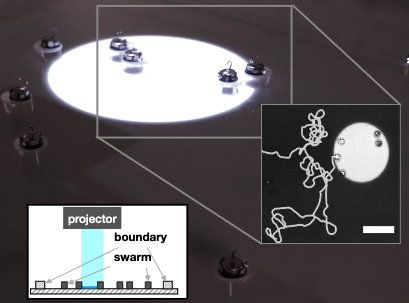 Whereas naturally occurring swarms thrive when crowded, physical interactions in robotic swarms are either avoided or carefully controlled, thus limiting their operational density. Here, we present a mechanical design rule that allows robots to act in a collision-dominated environment. We introduce Morphobots, a robotic swarm platform developed to implement embodied computation through a morpho-functional design. By engineering a three-dimensional printed exoskeleton, we encode a reorientation response to an external body force (such as gravity) or a surface force (such as a collision). This force orientation response adds a mechanical layer to the robot’s sense-act cycle at the swarm level, leveraging steric interactions for collective phototaxis when crowded. Enabling collisions also promotes information flow, facilitating online distributed learning. Each robot runs an embedded algorithm that ultimately optimizes collective performance. We identify an effective parameter that controls the force orientation response and explore its implications in swarms that transition from dilute to crowded. Experimenting with physical swarms (of up to 64 robots) and simulated swarms (of up to 8192 agents) shows that the effect of morphological computation increases with growing swarm size.
Whereas naturally occurring swarms thrive when crowded, physical interactions in robotic swarms are either avoided or carefully controlled, thus limiting their operational density. Here, we present a mechanical design rule that allows robots to act in a collision-dominated environment. We introduce Morphobots, a robotic swarm platform developed to implement embodied computation through a morpho-functional design. By engineering a three-dimensional printed exoskeleton, we encode a reorientation response to an external body force (such as gravity) or a surface force (such as a collision). This force orientation response adds a mechanical layer to the robot’s sense-act cycle at the swarm level, leveraging steric interactions for collective phototaxis when crowded. Enabling collisions also promotes information flow, facilitating online distributed learning. Each robot runs an embedded algorithm that ultimately optimizes collective performance. We identify an effective parameter that controls the force orientation response and explore its implications in swarms that transition from dilute to crowded. Experimenting with physical swarms (of up to 64 robots) and simulated swarms (of up to 8192 agents) shows that the effect of morphological computation increases with growing swarm size.
SCIENCE ROBOTICS
By: Ben Zion, Matan Y. / Fersula, Jeremy / Bredeche, Nicolas / Dauchot, Olivier
Volume 8, Issue 75, Article Number 6140
DOI: https://doi.org/10.1126/scirobotics.abo6140
Published FEB 2023

